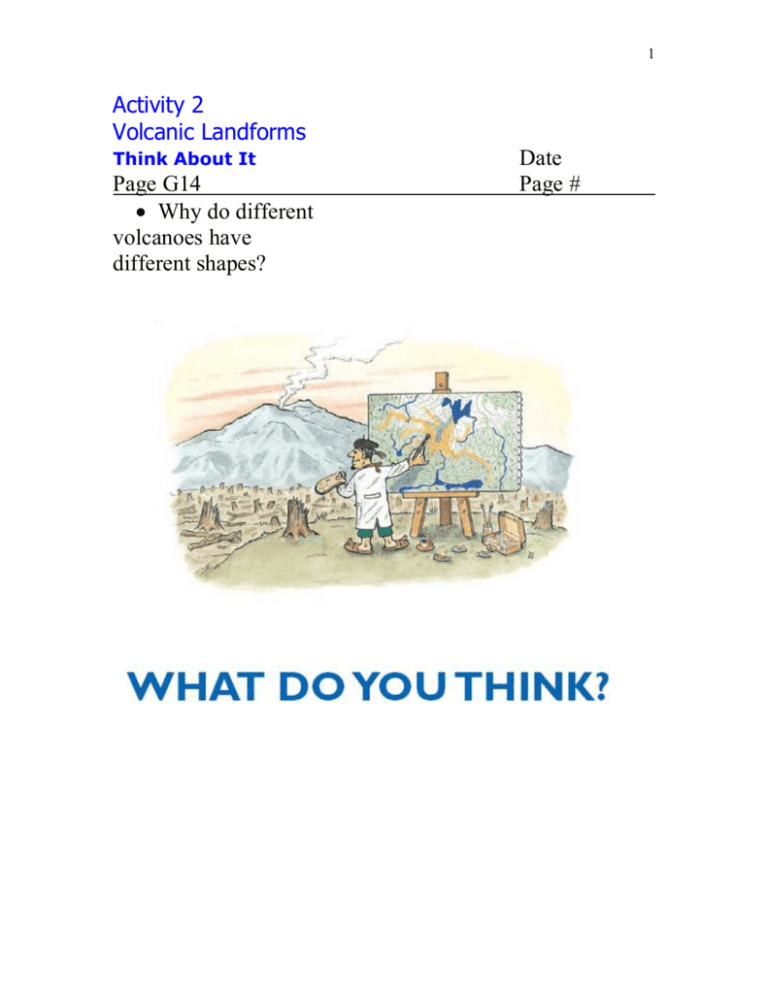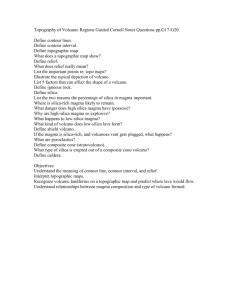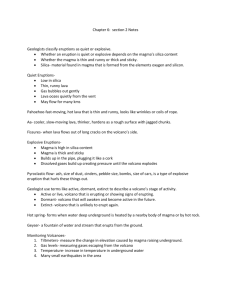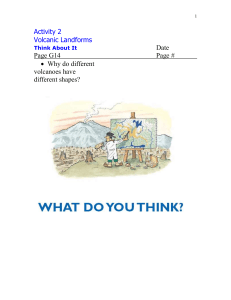Act. 2 Volcanic Landforms
advertisement

1 Activity 2 Volcanic Landforms Think About It Page G14 Why do different volcanoes have different shapes? Date Page # 2 Activity 2 Investigate Pages G15-16 7a. Describe two similarities between the maps. 7b. Add a legend to your map. Include a scale, north arrow, and contour interval. 7c. What do the shaded regions on the map of Mt. St. Helens represent? Date Page # 3 7d. Why do the shaded regions cross the contour lines at right angles? 7e. Which part of Mt. St. Helens is steeper, the slope between 1500 m and 2000 m, or the slope between 2000 m and 2500 m? Explain. 7f. What are the lowest and highest elevations on the map of Mt. St. Helens? What is the difference in elevation between these two points? 7g. If lava erupted at point A, would it flow to point B or D? Explain. 4 Activity 2 Digging Deeper Pages G17-21 Contour line Date Page # a line on a map that connects points of the same elevation of the land surface Contour interval the distance between two contour lines on a topographic map Topographic map A map showing the features of the land surface 5 Contour lines •contour lines never cross •the closer together the contour lines, the steeper the slope •contour lines for volcanic craters are marked with tick marks - - - •every fifth contour line on a map is darker and its elevation is always marked Volcano’s shape depends on the amount of silica in the magma Magma with high silica magma that is high in silica does not flow very easily This type of magma produces very violent, explosive eruptions because gases are trapped and the pressure builds 6 Magma with low silica Magma that is low in silica flows far and easily Trapped gases can escape easily, causing quiet, non-explosive eruptions http://www.classzone.com/books/earth_science/terc/content /visualizations/es0905/es0905page01.cfm?chapter_no=visu alization http://www.volcanovideo.com/Movies/FlowingLava.mov Shield volcano a volcano with gently sloping sides and a wide base They are formed from basaltic lava that is very fluid, and doesn’t pile up to build steep sides Examples Kilauea and Mauna Loa, Hawaii 7 Tephra pieces of rock and hardened lava that are thrown out of a volcano during an eruption Cinder cone volcano a volcano made of layers of tephra The tephra piles up to create a steep, cone-shaped volcano Example Parícutin, Mexico 8 Composite cone (stratovolcano) a volcano made of alternating layers of lava and tephra Composite volcanoes are tall and have steep slopes because the lava does not flow easily Examples Mount St. Helens, Washington state; Mount Fuji, Japan 9 Caldera a large crater that forms after a volcano collapses in on itself Example Crater Lake, Oregon (caldera that filled with water) 10 11 Activity 2 Check Your Understanding Page G21 1. Explain in your own words the meaning of a contour line, contour interval, and topographic map. 4. Why do silica-poor magmas produce broad volcanoes with gentle slopes? 5. Why does high-silica magma tend to form volcanic domes with steep sides? 6. How is a caldera formed? Date Page # 12 Activity 2 Understanding and Applying Pages G21-22 2. Sketch a contour map of a volcano that shows: a. gentle slope b. steep slope c. a crater 4. Sketch a topographic map of a shield volcano and a composite cone. Date Page #









